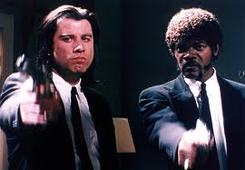
I find it interesting for a couple of reasons, not the least of which is that it’s totally inaccurate. Nonlinearity in all of the nonlinear structures is (as far as I can see) always arranged so that the end always occurs at the very end of the film, or else, if there are multiple stories, that the film ends on the end of one very powerful story, thereby getting its strong ending from that story’s ending, piggybacking, if you like, on that story’s pull to closure ( as happens in Pulp Fiction for example).
There is always a striking or thought-provoking resolution, indeed, nonlinear forms very often clearly show what I call a ‘Rosebud’ twist ( a term referencing Citizen Kane), where only in the final moments is the crucial answer given and this answer turns what seemed to be the message and point of the film on its head. In fact, it’s this pleasing tying-up of threads in an unexpected way that gives nonlinear films much of their pleasure.
But let’s move on. What practical help is this little dictum offering? Well, none. To the contrary, not only has it pointed you towards disaster by suggesting that you don’t have to have the end of the story at the end but it begs a dozen questions. Let’s look at it. ‘Every film has a beginning, middle and end but not in that order’. Surely one has to say: ‘ That sounds really useful, but can you please elaborate? Your comment implies that you have come to this conclusion after studying these forms in some detail (otherwise how could you make such a sweeping and apparently authoritative statement?), hence, can you please list these different orders, with examples? Please also explain by what rules, if any, one should choose to use any individual order? Is there any particular form of story content to which each is best suited? And please may I have some technical details here. How precisely am I to jump between the three components? Your argument is premised on there being three distinct parts to the story that one reorders. How do you define those parts? I need to know so that I know precisely where to start the reordering. How do we define the end of the beginning and the start of the middle and the end of the middle and the start of the end?
I’m not being smart here. These questions are the ones you really have to ask about the practical mechanics of non-linear. Where you jump stories is vital. Films crash and burn if you jump at the wrong places. Personally, I’ve spent years studying how and when and why nonlinear stories jump at the points that they do, and what effect each sort of jump creates for the audience and what sort of material suits what sort of structure. I had no choice about this because the jumps to and fro between stories make or break the nonlinear film and you need to choose the right structure to tell your story or it won't work. I’d say, for example, that many nonlinear forms open on the second act turning point of one of their stories then jump to its disturbance.
My only request is for precision and seriousness. Bottom line. Let’s have a proper debate about nonlinear.
 RSS Feed
RSS Feed


